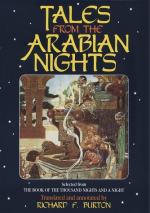Aladdin; Or, the Wonderful Lamp—p. 31.
Those scholars who declared a number of the tales in Galland’s “Mille et une Nuits” to be of his own invention, because they were not found in any of the Arabic Ms. texts of The Nights preserved in European libraries, were unconsciously paying that learned and worthy man a very high compliment, since the tales in question are among the best in his work and have ever been, and probably will continue to be, among the most popular favourites. But that fact that Galland seized the first opportunity of intimating that two of those tales were not translated or inserted by himself ought to have been alone amply sufficient presumptive evidence of his good faith with regard to the others.
A friendly reviewer of my “Popular Tales and Fictions” etc. states that modern collectors of European Mrchen, though “working from 100 to 150 years after the appearance of the ‘Thousand and One Nights,’ in European literature, have not found the special versions therein contained distributed widely and profusely throughout Europe,” and that my chapter on Aladdin is proof sufficient that they have not done so. The reviewer goes on to say that I cite “numerous variants, but, save one from Rome, variants of the theme, not of the version; some again, such as the Mecklenburg and Danish forms, are more primitive in tone; and all lack those effective and picturesque details which are the charm of the Arabian story, and which a borrower only interested in the story as a story might just be expected to retain.’’[FN#385]
But it is not contended that the folk-tales of Europe owe much, if indeed anything at all, to the “Arabian Nights,” which is not only as it now exists a comparatively modern work—Baron de Sacy has adduced good reasons for placing the date of its composition in the middle of the 9th century of the Hijra, or about 1446 A.D. but was first made known in Europe so late as the first quarter of the last century. Several of the tales, and incidents of the tales, in the “Thousand and One Nights” were current in Europe in the 12th century— imported by the Moors of Spain, and by European travellers, pilgrims, and minstrels from the East. Thus the Arabian tale of the Ebony (or Enchanted) Horse is virtually identical with the Hispano-French romance of Cleomades and Claremonde; that of Prince Kamar al Zaman is fairly represented by the romance of Peter of Provence and the Fair Maguelone. The episode




